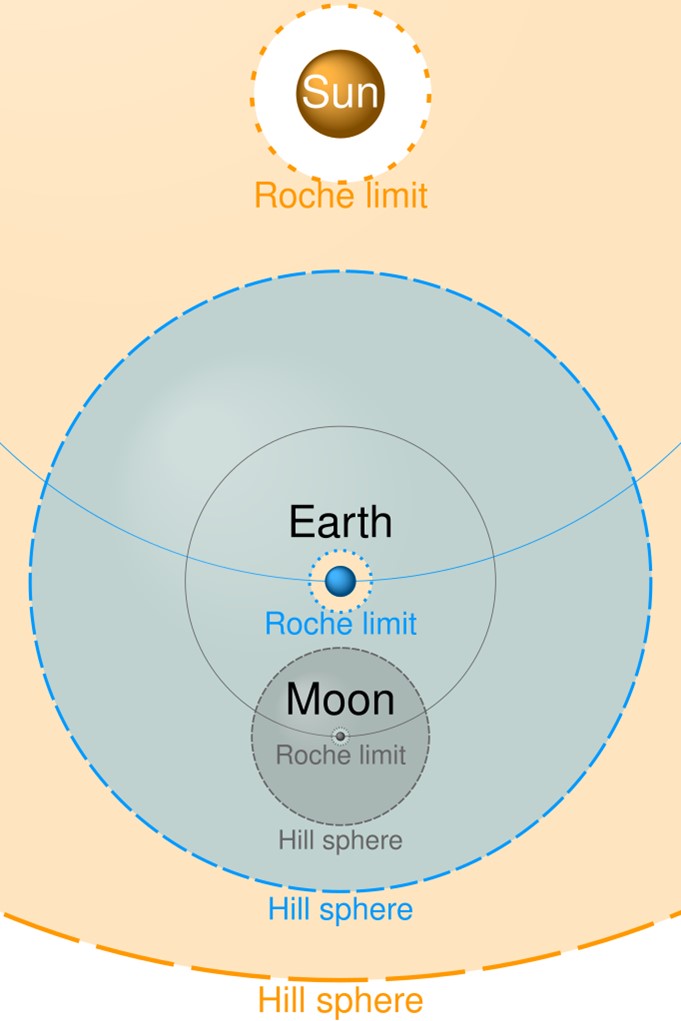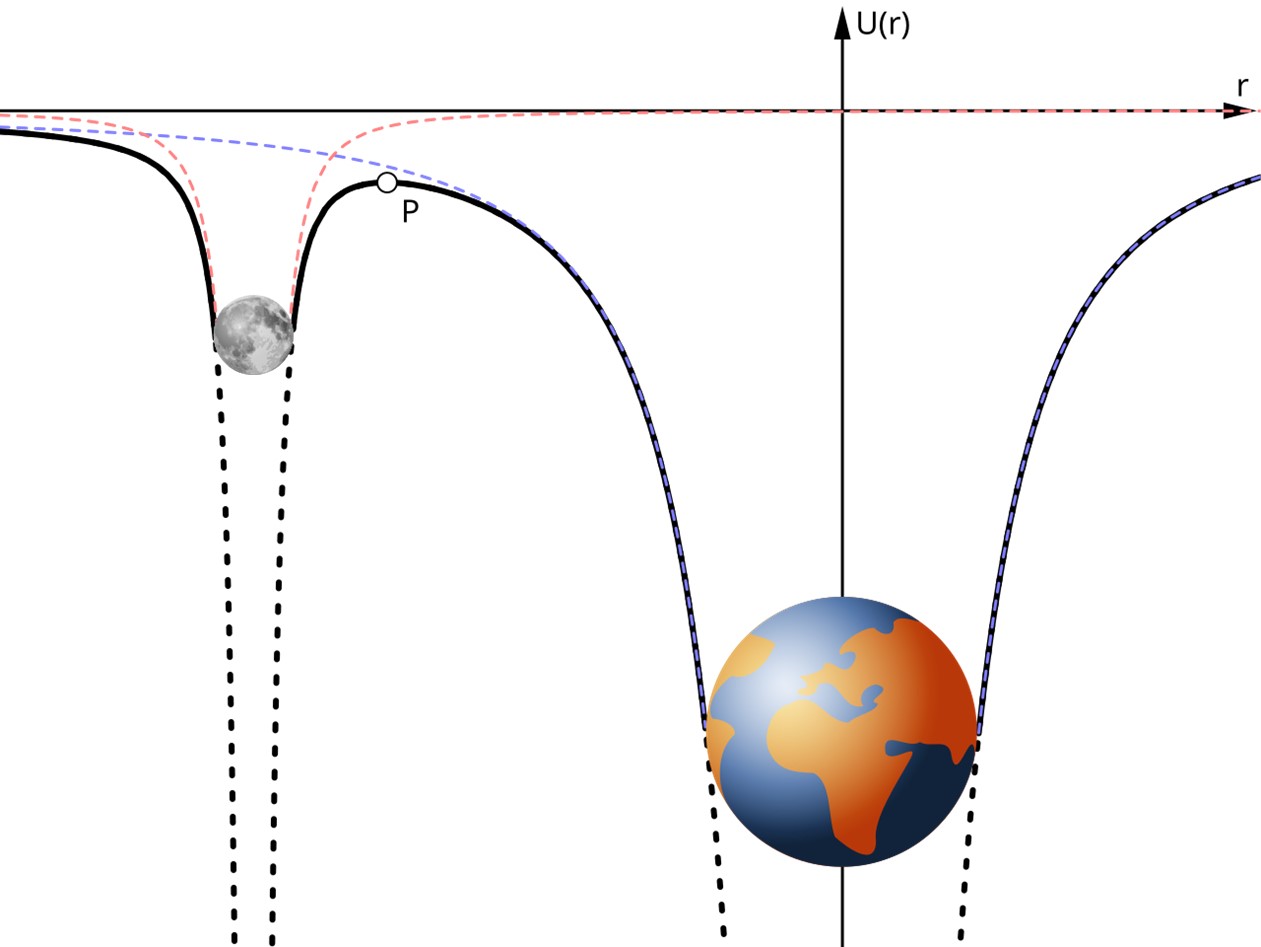
Credit: NASA, ESA and the Hubble Heritage Team (STScI/AURA), public domain, via Wikimedia Commons
The Moon has inspired humans for countless generations.
Among moons, ours is large, about a quarter the size of Earth. But we have only one. Other planets have many. And some have none. Where do they come from, and how do planets acquire them?
Our moon is unique in the solar system. It came from an impact, when an asteroid the size of Mars slammed into Earth 4 billion years ago and smashed off a body that would become the Moon.
Other moons are ancient astral bodies that were created along with the planets when the solar system took shape. Still more are former asteroids, which passed near enough to a planet to be captured in its orbit.
Small planets closer to the Sun have small gravitational fields. In order to trap a passing asteroid, these would have to combat a stronger gravitational pull from the nearby Sun. For this reason, Mercury and Venus have no moons.
Large planets farther from the Sun have stronger gravitational fields that can more easily overcome a weaker pull from the distant Sun, so they have many moons—95 for Jupiter and 146 for Saturn—more than any other planet.
Some of those moons are nearly the size of Earth, may have oceans, and may even have undersea life, as we’ve talked about in prior episodes. These moons may be targets for future space missions, inspiring humans of future generations.
Background
Synopsis: Earth’s bright but solitary moon has influenced our planet for billions of years. But elsewhere in our solar system, Saturn has 146 and Jupiter has 95 identified moons, some larger than Mercury. However, neither Mercury nor Venus have a natural moon satellite. How are moons of the planets in our solar system distributed, and how do planets capture and keep their moons?
- While Earth’s moon has influenced human imagination for millennia, it has also influenced large scale physical processes that make the world we live in so unique.
- The Moon is a relatively large satellite for a planet the size of Earth, its diameter (2159 mi [3476 km]) is about 27% of Earth’s diameter (7926 mi [12,756 km]). It is larger than the planet Mercury and is the fifth largest moon in the solar system.
- We described how our moon controls Earth’s tides and rotation while stabilizing our planet’s tilt and seasons in ED-367 If Earth Had No Moon.
- We talked about how the Moon influences the length of our day in ED-168 The Day’s Getting Longer.
- The third planet away from the Sun, Earth only has one moon, but some other near-Earth objects orbit the Sun in resonance with Earth.
- Some of the planets in our solar system are barren of moons, while others have more natural satellites (the scientific term for moons) than we can count.
- The closest planet to the Sun, Mercury, has no moon.
- The Earth-sized second planet from the Sun, Venus, has no moon.
- The fourth planet from the Sun, Mars, has two tiny natural satellites, Phobos (17 × 14 × 11 mi [27 × 22 × 18 km]) and Deimos (9 × 7 × 6.8 mi [15 × 12 × 11 km]).

Moons of our solar system scaled relative to Earth.
Credit: NASA, public domain, via Wikimedia Commons - Moving farther from the Sun, the gas giant Jupiter has 95 moons that have been officially recognized by the International Astronomical Union, but the planet has thousands of smaller objects in its orbit.
- Galileo Galilei discovered Jupiter’s four largest moons in 1610, including the largest moon in our solar system, Ganymede, which is 66% of the diameter of Earth or 150% the size of the Moon.
- Its other large moons are Callisto, Io, and Europa, which is 90% as large as Earth’s moon.
- In addition to its iconic rings, Saturn has 146 identified moons in its orbit, more than any other planet.
- Discovered in 1655, Saturn’s largest moon, Titan, ranks second in size in our solar system and is the only moon in the solar system known to have an atmosphere.
- Icy Enceladus is only a tenth of the size of Titan, but both are of interest for future space missions.
- Saturn’s rings are composed of billions of chunks of ice and rock ranging from dust to mountain size in scale. The rings are only about 30 ft (10 m) thick, but extend as much as 175,000 mi (282,000 km) from the planet.
- Uranus has 28 known moons, including five major moons: its largest Titania (discovered in 1787), Oberon, Umbriel, Ariel and Miranda.
- Neptune has 16 known moons. Its largest moon, Triton, was discovered just 17 days after Neptune was discovered in 1846.
- Even non-planet Pluto has five moons. Its largest moon, Charon (discovered in 1978), is about half its size, making it the largest known moon relative to the size of its parent planet in our solar system.
- How do the planets hold onto their respective moons? It’s all about gravity.
- Every object with mass exerts a gravitational force that attracts nearby objects, that’s why we don’t fly off Earth’s surface.
- The Sun has the largest gravitational force in the solar system, so planets attracted by the Sun orbit the Sun. So, why don’t all the moons orbit the Sun, too?
- In order for an object to orbit a body in space, it has to be close enough to the body so that the body’s gravitational attraction dominates compared to the Sun or other nearby objects.
- In 1878, American astronomer George Hill described gravitational interactions building on the celestial mechanics work of French astronomer Édouard Roche.
- The region of gravitational potential is called the Hill sphere; it is determined from the masses of the two bodies and the distance between them.
- For the Earth–Sun example, Earth’s gravity dominates for a distance of 932,000 mi (1.5 million km) from Earth’s center. Outside of that, the Sun’s gravity takes over.
- The edge of the Hill sphere is where gravitational forces between the two bodies balance, creating a narrow equilibrium region.

Comparison of the Hill spheres and Roche limits of the Sun-Earth-Moon system (not to scale) with shaded regions denoting stable orbits of satellites around each body. A smaller sphere inside of the Hill sphere is defined by the Roche limit, within which a satellite would be torn apart. Manmade satellites must orbit outside of this limit.
Credit: Cmglee, CC BY-SA 4.0, via Wikimedia Commons
The Moon’s Hill sphere extends 37,300 miles (60,000 kilometers) from its center. This conceptual diagram shows the gravitational potential of Earth (blue line), the Moon (red line) and their combined gravitational potential (black thick line). Objects closer to the Moon than P are within the Moon’s Hill sphere and would orbit the Moon instead of Earth. Earth and Moon are to scale, but distances are not.
Credit: MikeRun, CC BY-SA 4.0, via Wikimedia Commons - Inner planets have smaller Hill spheres because of their proximity to the Sun, while outer planets have large Hill sphere radii because of distance and size.

Logarithmic plot of the radius of the Hill sphere of our solar system's planets in kilometers. For Mercury–Sun the distance is 108,000 miles (175,000 kilometers). For Neptune–Sun the distance is 71.5 million miles (115 million kilometers).
Credit: Sphère_Hill_Planètes.png: Tos; derivative work: Fuhghettaboutit, CC0, via Wikimedia Commons
- How did these planets get all their moons? Astrophysicists have a couple of ideas.
- Some older moons probably formed at the same time as the solar system and planets did, coalescing from the protoplanetary disk of gas that rotated around the early Sun.
- But most of the moons in the solar system are thought to have been asteroids that were gravitationally captured by their planets.
- Earth’s moon is a special case, because it is thought to have formed when a Mars sized planet (named Theia) crashed into Earth about four billion years ago, causing a big chunk to fly off, and this chunk was gravitationally captured within Earth’s local gravitational system (or Hill sphere).
- And why are Mercury and Venus moonless? Have a look at the bar graph.
- For Mercury, its tiny Hill sphere would have made it difficult for the planet closest to the Sun to attract and keep a moon.
- The chances would be much better for Venus with a Hill sphere radius similar to that of Mars. But in order to catch a moon, a large asteroid would need to have approached the planet and missed it. So, scientists think maybe Venus didn’t get a chance to catch a moon, while lucky Mars caught Phobos and Deimos. The rest, is planetary history.

